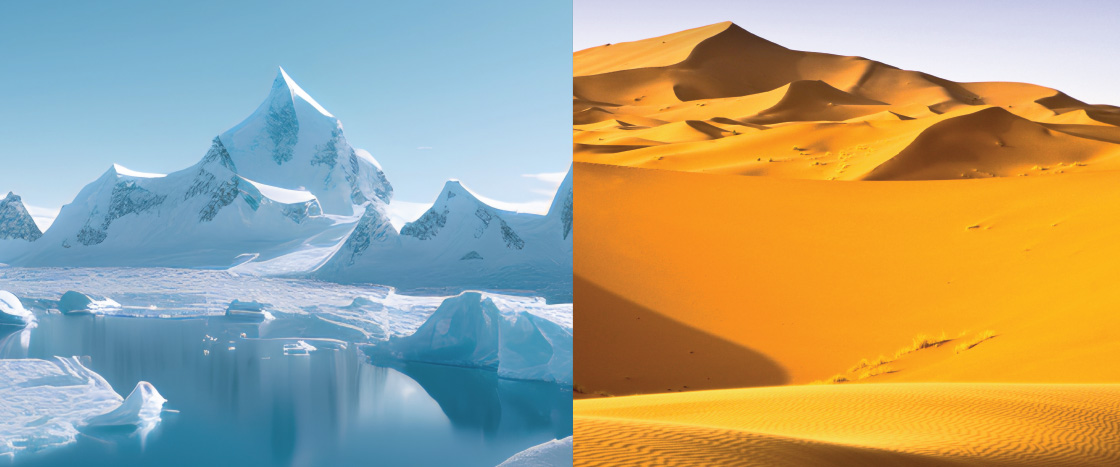Antarctica and the Sahara are two of the most extreme places on Earth. One is freezing cold, while the other can be scorching hot. If you had to pick one to call home, which would you choose?

Would You Rather Live in Antarctica or the Sahara?
If you had to pick one to call home, which would you choose?
Learning Objective: Students will gather and use information about Antarctica and the Sahara to support an argument.
Antarctica
Shutterstock.com
SEVERE CLIMATE
Jim McMahon/Mapman®
The icy continent of Antarctica is Earth’s southernmost landmass.
Antarctica is the coldest place on Earth. The temperature drops to
-112° Fahrenheit in winter. Because new snow and rain rarely fall, it’s considered a desert—the largest in the world!
AMAZING LANDSCAPE
© Cover Images via ZUMA Press
Research station
Antarctica is covered in a layer of ice up to 3 miles thick! It’s also home to more than 100 volcanoes, most of which are below the ice. Two are active, with the most recent eruption in 2023.
UNIQUE ANIMALS
Bryan and Cherry Alexander/NaturePL.com
Emperor penguins
Many types of penguins, whales, and seals live in Antarctica and its surrounding waters. Emperor penguins have densely packed feathers and feet filled with fat. These adaptations help keep them warm.
HOW YOU’D SURVIVE
VINCENT JANNINK/AFP via Getty Images
Snotsicle
No humans are native to Antarctica. But a few thousand people live there—mostly scientists working in one of 70 research stations. If you joined them, you’d sleep in a tiny bedroom. Very little grows in Antarctica, so all your food would be delivered by plane or ship. Outside, your snot would freeze, forming what’s known as a “snotsicle.” If you stay for the winter, make sure you’re not afraid of the dark! At the South Pole, Earth’s southernmost point, the sun doesn’t rise for 6 months.
THE SAHARA
Shutterstock.com
SEVERE CLIMATE
Jim McMahon/Mapman®
The sand-covered Sahara desert spans 3.5 million miles across North Africa.
The Sahara is the largest hot desert in the world. Some areas get barely any rain. During the day, temperatures can soar to over 120ºF! At night, they can drop below freezing.
AMAZING LANDSCAPE
Up to 20 percent of the Sahara is covered in dunes, enormous mounds of sand created by the wind. Some can be 600 feet high—that’s twice as tall as the Statue of Liberty!
UNIQUE ANIMALS
Shutterstock.com
Fennec fox
Fennec foxes are one of many animals native to the Sahara. They burrow in the dunes to avoid the sun. Big ears help them release heat, and fur protects their paws from the hot sand.
HOW YOU’D SURVIVE
Jason Venus/NaturePL.com
Oasis
If you lived in the Sahara, you might settle near an oasis. That’s an area of fresh water in a desert. You could plant palm trees around the water to keep sand from blowing in. Or maybe you’d become a nomad. That’s a person who constantly travels. For centuries, people have crossed the Sahara, living in tents and stopping at wells or an oasis for water. Either way, you’d need special clothing to protect yourself from the sun, the cold nights, and sandstorms! Many people here wear long robes and head coverings.
Where would you rather live?
Where would you rather live?
Where would you rather live?
1. PREPARE TO READ (10 minutes)
Make an initial choice and explain the reasoning behind it.
- Tell students to imagine they must choose to live in a new place: either the icy continent Antarctica or the scorching-hot Sahara desert. Ask them to close their eyes and imagine what it would be like to live in each location. Then have them turn and talk with a partner, sharing what they might see and feel at each place.
- Ask: Would you rather live in Antarctica or the Sahara? (If needed, explain the “Would You Rather . . . ?” game. In this game, a person must make a tricky choice between two things. There isn’t a “right” answer, but you must choose one and defend your choice.) Remind students the question is asking where they would live, not just visit. Let students record their initial choice and jot down one or two sentences about the reasoning behind their decision.
- Play the video “Would You Rather Live in Antarctica or the Sahara?” Give students time to change their choice and/or add any new information from the video to their reasoning. Designate one side of the room “Antarctica” and the other side “the Sahara.” Tell students they’re allowed to change their mind later, but for now they should go to the side that matches their choice. Tally up each side and record it on the board. Have students return to their seats.
2. READ AND EVALUATE (15 minutes)
Gather information and discuss text evidence.
- Read the article aloud or have students read it independently. Ask: What information did you find most surprising or interesting? (e.g., Both places are deserts.) Let students discuss in pairs. Then reconvene as a class and ask for volunteers to share. Compare sections with the same titles, like “Severe Climate” and “How You’d Survive.”
- Ask students: Did your original choice change? Why or why not? Remind students that new information could change one’s mind—and that’s OK! As we learn more, our thinking often changes.
3. RESPOND TO READING (20 minutes)
Write and evaluate an evidence-based opinion.
